
As SpaceTech startups are getting more familiar to VCs and tech community in general, in order to structure the understanding of ecosystem, I’ve put together a market map of space-related startups.
Spreadsheet with all the data (and even more) is availbale here, please feel free to use it! If I am missing something please tweet me @Val_Komissarov
Assumptions
Worth to mention that only startups are included in this market map (as you’ll see that such companies like Boeing, Lockheed Martin and Digital Globe are not presented). Also, not only VC investments were took into account.
I’ve decided to outline 4 segments on SpaceTech market:
- Satellites + Subsystems + Miscellaneous
Companies developing and operating microsatellite constellations for different purposes (Earth Observation, gathering weather-related data, providing worldwide Internet access), as well as satellites’ subsytems developers are included. Also I’ve included companies providing various microgravity research services (primarily on ISS) - Launch Vehicles + Space Toursim + Moon Exploration
Startups developing various launch vehicles (LV), space tourism and moon exploration spacecrafts are fall into this category - Ground Stations
Companies working on next-generation ground stations networks, using for receiving data from spacecrafts (including satellites) and operating them are presented in this category. - Value-added Services
Startups building products and services for various industries/verticals on top of the remote sensing data are included
Findings
1. Power law in SpaceTech investments
There is definately a power law in where investments in SpaceTech companies are flowing: only 6 companies accounting for more than 85% of all investments (thanks to CB Insights and their Frontier Tech report for the data)

2. “Satellite” is the most popular investment thesis in SpaceTech at the moment
If we compare the amount of funding of rocket- and satellite-related startups, “launch-vehicle” companies raised $1,5 bn. more than satellite ones, $2444,5 M against $957,2 M (which is intuitively clear that it is much more capital-intensive to build a rocket than to build a satellite).
However, if we exclude "mega-deals" such as $1,25 bn. SpaceX, $600M Virgin Galactic and $500M OneWeb & Blue Origin ones, than satellite-related companies raised much more investments. Moreover, startups, building value-added services on top of the remote sensing data also raised more than launch vehicles manufacturers
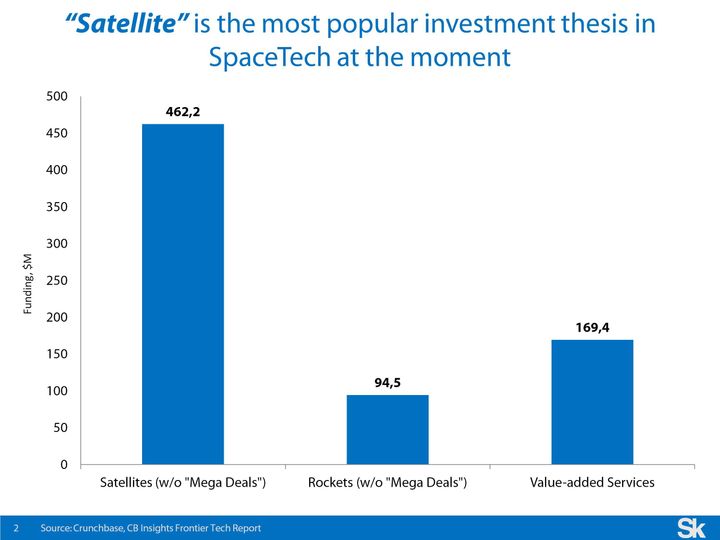
3. Satellite-related startups are younger than rocket-related ones
Average founding date of satellite-related and value-added services companies is close to 2012, while an average rocket-related company was founded in 2008.
Here is more detailed year-by-year breakdown:

4. Earth Observation is the most crowded segment among satellite-related startups
Categorizing satellite-related companies (see more detailed classification above), Earth Observation is the most crowded segment on the market with already 13 startups in this space and $326,7M raised.
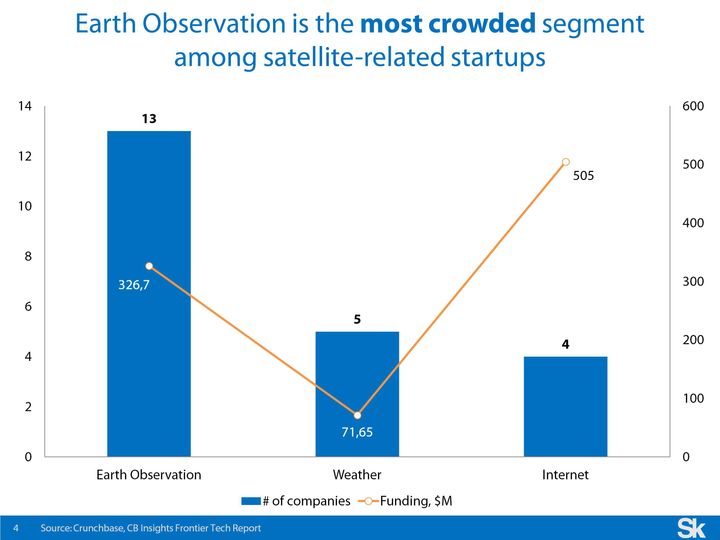
5. New Space EO data providers are moving towards full-stack approach
One of the biggest trends in Earth Observation industry is that both startups and mature companies are shifting from being data providers only to a more “full-stack” approach. Planet Labs, Terra Bella, Urthecast, Digital Globe and Astro Digital are building APIs for developers (say, farm management software startup) to work with satellite imagery and web-interfaces providing easy access to imagery from the cloud — in other words are building platform-based businesses.
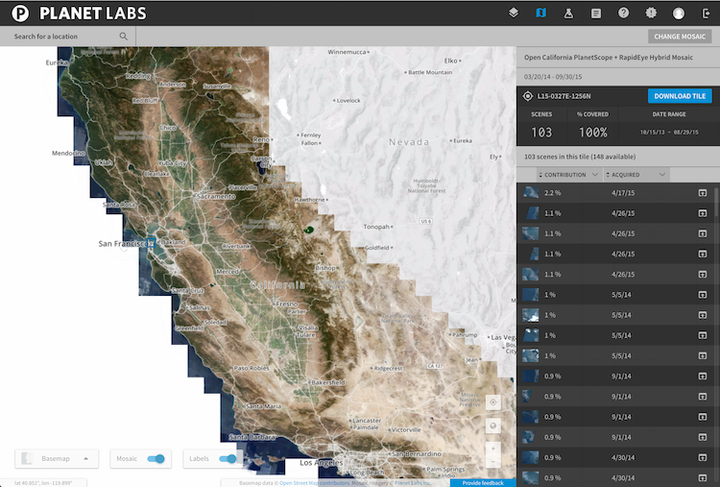
6. Satellite imagery analytics is a hot topic
Another emerging area can be described as “Deep Learning + Satellite Imagery”. Such startups as Orbital Insight (recently raised $20M Series B), Spaceknow and Ursa are applying AI to gather insights on worldwide economic trends and global processes. Examples are prediction of retailers’ (e.g. Walmart) profits before their quarterly report is published by counting cars on parking lots or a worldwide scale crop yields forecast.
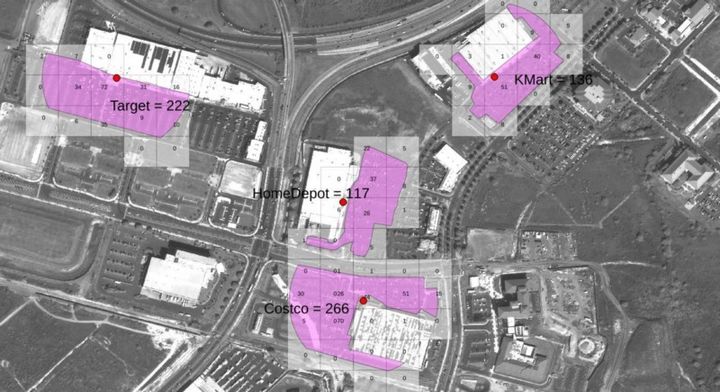
Notably, government and intelligence customers (which have historically been the main buyers of satellite imagery products) are also very interested in such analytical products (more on this here).
“…we’ll buy imagery analysis as a commodity — much like we buy foundation data today” — Robert Cardillo, Director of National Geospatial Agency (the largest satellite imagery buyer at the moment).
Another segment of satellite imagery analytics startups consists of companies delivering products based on basic (“non-AI”) remote sensing data analysis, such as NDVI maps or change detection and adding some data science for industry-oriented insights (how many fertilizer should we put in this field).
7. Agriculture is the most popular focus area of Value-Added Services startups
Breaking down satellite imagery startups, most of them are focusing on agriculture: while “Deep Learning + Satellite Imagery” products can be applied to virtually every industry, as algorithms can measure almost everything (roads, airplanes, buildings, oil tanks and so on), however there are some examples of agriculture-oriented services in this area, like Descartes Labs. Speaking of “basic imagery analytics” startups, most of them are delivering insights to farmers.
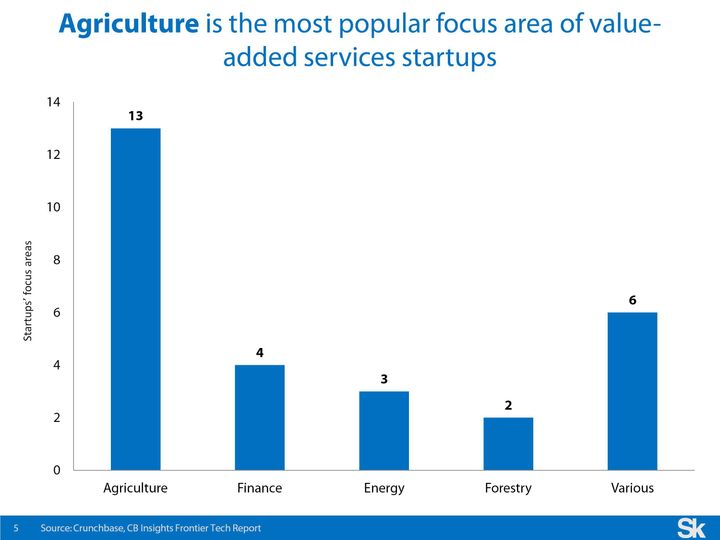
8. Weather / Environment is gaining traction
There has been a lot of activity in weather-related markets ranging from significant M&A deals (IBM acquired Weather Company’s digital business for $2bn. in 2015) to technology breakthroughs (Panasonic developed global weather model which is more accurate then government-funded ones) and national policies changes (recent hearings in Congress on private sector weather forecasting). Startups like Spire, deploying 100+ satellites constellation collecting data on the current state of the atmosphere, and Aerostate, combined multiple data sources, such as pollution databases, remote sensing data and machine learning to deliver hyperlocal air quality forecasts are riding this wave.
8. Ground stations are another emerging area
As New Space revolution impacted how satellites are built and rockets are launched, the next frontier left is ground segment. Companies like RBC Signals, Atlas Space Operations and Spaceflight Industries are bulding worldwide ground stations networks and providing capacity to microsatellite-related startups, academia and government customers, applying “software” business models and Silicon Valley mentality.
9. Launch vehicle startups are pretty questionable (as for me)
While most of the startups (Rocket Lab and Firefly Space Systems to name a few) in this area are developing small launch vehicles (LV), aimed mostly on an emerging microsatellites market, it is important to understand that it is much more expensive to launch a satellite on dedicated rocket than on a piggy-back launch (as a secondary payload). Here is the math: price per kg to be launched to Low Earth Orbit (LEO) on Falcon 9 (SpaceX) is 2719 $/kg ($ 62*10⁶ / 22 800 kg) while it costs 32667 $/kg ($ 4,9*10⁶ / 150 kg) to be launched on Electron (Rocket Lab)
As it can be seen price is definately not what gives small LV companies an edge. It’s schedule where they are truly competing: dedicated launch vehicle can provide customers desired launch time (say time to market) and orbital parameters, while secondary payload (in case of launch on SpaceX, ULA and others) is separated whenever it suits the primary, in whichever orbit suits the primary, and, more importatly, is launched only when the primary payload is ready (which can cause significant postpones to launch a bunch of cubesats).
However, it’s unclear for me would such companies be able to build sustainable business (great read on this here), especially taking into account military programs on small launch vehicles, such as Boeing ALASA project.
Conclusion
Summing up I’d like to list 3 companies that I think are the most promising ones and build up some kind of “Dream SpaceTech portfolio”
BlackSky Global
Subsidiary of a Spaceflight Industries, recently raised $25M to launch a constellation of 60 remote sensing satellites of sub-meter resolution providing up to 90 revisits daily. Taking into account that low number of launch opportunities is one of the key microsatellite-related companies barriers to entry, and, consequently, Spaceflight Industries is one of the major launch services providers — BlackSky look pretty attractive. Moreover, company is also developing its “platform” capabilities (full-stack approach detailed above) with acquision of OpenWhere, startup working on geospatial data platform and API to deliver data/insights to customers.
Spire
This startup is deploying “first commercial weather satellites” constellation utilizing GPS-RO technology, already launched 12 satellites and signed a number of launch contract with Rocket Lab to launch around 40 more. Despite that selling weather data (or forecasts) is quite challenging, market is evolving and weather opportunity might become a multibillion one. Spire already raised $66,5M, hired some senior people from the industry, closed a deal with Indonesian governement and is on it’s way towards capturing the market, while competitors (PlanetiQ) are just going to be launched this year
Orbital Insight
Company’s vision is to build a some kind of “macroscope” to gather insights on worldwide-scale processes, combining satellite imagery and deep learning for a variety of customers from asset management firms to non-profit organizations, such as World Bank, and government/intelligence clients. Speaking of competition, while algorithms are not quite an advantage and a barrier to entry for others at the moment (due to availability of open-source computer vision frameworks), established partnerships and a qualified team are, and this is where Orbital Insight seems to have a head start.
Summing up, hope this research would be helpful for those who isn’t deeply involved in aerospace, also, please feel free to reach out (@Val_Komissarov) if you feel I’m missing something.
Here is a spreadsheet with all the data.
Stay tuned for more insights on SpaceTech, Drones and beyond!
